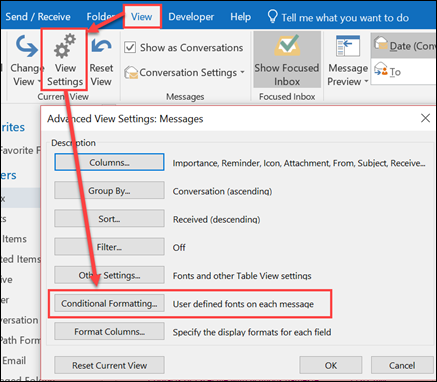
Then click “OK” after adding and organizing the fields.Ĭhanging the Inbox View in Outlook – Instructions: A picture of the “Show Columns” dialog box in Outlook. To change its order in the list of columns, select that field from the list to the right and then click the “Move Up” and “Move Down” buttons until it is in the desired place. To add one of these fields to your new view, select it in the left list and then click the “Add” button to add it to the list to the right. Then use the drop-down in the upper-left corner to choose a set of fields to display in the left list. If changing the Inbox view in Outlook by adding columns to the view is what you want to do, then click the “Columns…” button in the “Advanced View Settings” dialog box to open the “Show Columns” dialog box. Changing the Inbox View in Outlook by Changing Advanced View Settings If You Want Help Changing the Inbox View in Outlook by Adding Columns to the View Based on your selected base view type, however, not all of the buttons will necessarily be available.Ĭhanging the Inbox View in Outlook – Instructions: A picture of the “Advanced View Settings” dialog box in Outlook. This dialog box has seven buttons you can click to set advanced view options. Then click “OK” to launch another dialog box, called the “Advanced View Settings” dialog box. You can choose either the “This folder, visible to everyone,” “This folder, visible only to me,” or “All Mail and Post folders” option. Your choices include “Table,” which lays out the view’s items in columns and rows “Timeline,” which shows items accessed over a time period “Card,” which lays out the items in a card view “Business Card,” which displays items using an alternate card view “People,” which display a list of people like the “People” view of the “Contacts” folder “Day/Week/Month,” which shows items in a day/week/month style or “Icon,” which shows icons for the items.Īfter selecting your base folder view, select who can see this new view.

Type a name for the new view into the “Name of new view:” text box.īelow that, select the type of view to create. Doing that then opens the “Create a New View” dialog box. If changing the Inbox view in Outlook by creating a new custom view is what you want to do, then click the “New…” button at the right side of the dialog box. Changing the Inbox View in Outlook by Creating a New, Custom View This same dialog box lets you customize the views of all the folders in Outlook.Ĭhanging the Inbox View in Outlook – Instructions: A picture of the “Manage All Views” dialog box in Outlook. You can also create, edit or delete your own custom views within this dialog box. You can select any view that you want and then modify it, or reset modifications made to one of the views. This dialog box displays all of the available views of the current folder and their associated settings.

You can also select the “Manage Views…” command from this menu to open the “Manage All Views” dialog box. The “Compact,” “Single,” and “Preview” choices appear by default. You can then select the name of any of the views listed in the menu that appears to apply them to your Inbox. Then click the “Change View” button in the “Current View” button group.

The first step in changing the Inbox view in Outlook is to open the Inbox folder. Changing the Inbox View in Outlook: Overview Changing the Inbox View in Outlook by Selecting a Different, Existing Viewīy changing the Inbox view in Outlook, you can organize your email to better suits your individual needs.


 0 kommentar(er)
0 kommentar(er)
